Bathtub
How to Replace a Bathtub

I’ve always enjoyed tackling home improvement projects, and replacing a bathtub is no exception.
In this step-by-step guide, I’ll show you how to confidently replace your old bathtub with a brand new one.
From assessing the condition of your bathtub to ensuring a watertight seal, I’ll walk you through each stage of the process.
So roll up your sleeves and let’s get started on this exciting and rewarding project!
Key Takeaways
- Assess the condition of your bathtub by examining the surface for cracks, chips, or stains and checking the caulking around the edges.
- Gather the necessary tools and materials such as a screwdriver, wrench, hammer, and utility knife, as well as a new bathtub, plumbing fittings, and plumber’s putty.
- Remove the old bathtub by disconnecting the plumbing and fixtures, turning off the water supply, and preparing the space for the new bathtub.
- Prepare the space for the new bathtub by removing old fixtures, measuring the area, ensuring a clean and level floor, and considering surrounding walls and fixtures.
Assessing the Condition of Your Bathtub
Now, you’ll want to take a close look at your bathtub to see if there are any visible signs of damage or wear. Start by examining the surface for cracks, chips, or stains. These can indicate structural problems that may need to be addressed before proceeding with a replacement.
Next, check the caulking around the edges of the tub. If it is deteriorating or missing, water can seep through and cause further damage. Additionally, inspect the plumbing fixtures to ensure they are functioning properly. If you notice any leaks or rust, it may be necessary to replace those as well.
Evaluating the bathtub’s structural integrity is crucial in determining whether a replacement is necessary. Once you have assessed the condition of your bathtub, you can move on to gathering the necessary tools and materials for the replacement process.
Gathering the Necessary Tools and Materials
First, you’ll want to make sure you have all the necessary tools and materials for the job. Choosing the right bathtub and finding professional assistance are key steps in this process. Here is a list of the tools and materials you will need:
| Tools | Materials | Additional Items |
|---|---|---|
| Screwdriver | Bathtub | Caulk Gun |
| Wrench | Plumbing fittings | Level |
| Hammer | Pipe wrench | Silicone Caulk |
| Pry bar | Plumber’s putty | Towels |
| Utility knife | Waterproofing membrane | Safety glasses |
When choosing a bathtub, consider factors such as size, material, and style to ensure it fits your needs and preferences. It’s also important to find professional assistance, especially if you are unfamiliar with plumbing or construction work. They can offer guidance and ensure the installation is done properly and safely.
Removing the Old Bathtub
To start, you’ll need to carefully disconnect the plumbing and remove any fixtures attached to the old bathtub.
Before beginning the process of replacing the bathtub, there are a few important plumbing considerations to keep in mind. Firstly, turn off the water supply to the bathroom to avoid any accidental leaks or water damage. Next, use a wrench to disconnect the water supply lines and the drain pipe connected to the bathtub. It’s crucial to drain any remaining water from the bathtub before proceeding further. Additionally, take note of the location of the shut-off valves for the bathtub, as you may need to turn them off during the installation of the new bathtub.
Now that the plumbing has been disconnected, we can move on to preparing the space for the new bathtub.
Preparing the Space for the New Bathtub
Before installing a new bathtub, there are a few important steps to take.
First, I’ll need to remove any old fixtures, such as faucets and showerheads, to ensure a clean installation.
Next, I’ll need to measure the area where the new tub will be placed, taking into account the dimensions of the tub and any surrounding walls or fixtures.
Removing Old Fixtures
Once you’ve gathered all the necessary tools, it’s time to start removing the old fixtures. This step is crucial in the bathtub replacement process and requires careful execution to avoid any damage or injury.
Here’s a step-by-step guide on how to effectively remove the old fixtures:
- Turn off the water supply and disconnect the water lines connected to the fixtures.
- Use a wrench or pliers to detach the drain assembly from the bathtub.
- Remove any caulking or adhesive around the fixtures using a putty knife or scraper.
- Unscrew or unfasten the screws, bolts, or nuts that hold the fixtures in place.
Measuring for New Tub
Now that the old fixtures have been removed, it is time to measure for the new bathtub. Accurate measurements are crucial in ensuring a proper fit during the bathtub installation process. To achieve measuring accuracy, follow these steps:
-
Measure the length and width of the existing bathtub. Use a tape measure and record the measurements in inches.
-
Measure the height of the existing bathtub from the bottom to the overflow drain. This will help determine the depth of the new bathtub.
-
Take note of any surrounding walls, plumbing fixtures, or other obstructions that may affect the placement of the new bathtub.
By accurately measuring the dimensions of the existing bathtub and considering any obstacles, you can choose a new bathtub that will fit seamlessly into your bathroom. This will ensure a smooth and successful bathtub installation process.
| Measurement | Inches |
|---|---|
| Length | |
| Width | |
| Height |
Clearing the Area
To clear the area for installation, make sure to remove any objects or furniture that may obstruct the process. This step is crucial to ensure a smooth and efficient bathtub replacement.
Here are some important points to consider:
-
Clear the Path: Remove any rugs, mats, or other floor coverings that may make it difficult to maneuver the old bathtub out and the new one in.
-
Protect the Walls: Cover the walls surrounding the bathtub area with plastic sheets or drop cloths to prevent any damage during the removal and installation process.
-
Disconnect Plumbing: Before removing the bathtub, turn off the water supply and disconnect any plumbing connections to avoid water leakage and potential damage.
-
Secure Fragile Items: If there are any delicate objects or fixtures near the bathtub, such as mirrors or glass shelves, remove them or cover them with protective materials to prevent breakage.
Installing the New Bathtub
Before you start installing the new bathtub, make sure you have all the necessary tools and materials. It’s important to have a clear understanding of the steps involved in order to ensure a successful installation.
First, you will need to install the bathtub drain. This involves connecting the drain assembly to the drainpipe underneath the bathtub. Make sure to follow the manufacturer’s instructions for this step.
Next, you will need to choose the appropriate fixtures for your bathtub. Consider factors such as style, functionality, and budget when making your selection.
Once you have all the necessary tools and materials and have installed the drain and chosen the fixtures, you can proceed to the next step of connecting the plumbing fixtures to complete the installation process.
Connecting the Plumbing Fixtures
When connecting the plumbing fixtures in a bathroom, it’s crucial to ensure proper pipe connections. This involves accurately aligning and securing the pipes to prevent any leaks or disruptions in the flow of water.
Additionally, sealing and caulking are essential steps to maintain a watertight environment and prevent any water damage.
Proper Pipe Connections
Make sure you check that the pipe connections are properly sealed before installing the new bathtub. Proper pipe installation is crucial for ensuring proper drainage in your bathroom. Here are some important points to remember:
-
Check for leaks: Inspect all the pipe connections for any signs of leakage. Even a small leak can lead to water damage and mold growth over time.
-
Use the right materials: Make sure you use the appropriate materials for the specific type of pipes you have. This will ensure a secure and tight connection.
-
Tighten fittings properly: Use a wrench to tighten the fittings, but be careful not to overtighten and risk damaging the pipes or fittings.
-
Apply thread sealant: Use thread sealant tape or pipe joint compound on threaded connections to prevent leaks.
Sealing and Caulking
To ensure a watertight seal, apply caulking around the edges of the bathtub.
Proper caulking techniques are essential in preventing water damage and maintaining the integrity of your bathroom.
Start by cleaning the area thoroughly to remove any dirt, grime, or old caulk residue.
Use a caulk gun to apply a thin, even bead of silicone caulk along the joint between the bathtub and the wall.
Smooth the caulk using a caulk tool or your finger, ensuring it adheres properly to both surfaces.
Allow the caulk to dry completely before using the bathtub.
Regularly inspect and replace any deteriorating or damaged caulk to prevent water leakage and potential damage to the surrounding areas.
Testing for Leaks
Regularly inspecting and fixing deteriorating or damaged caulking is important to prevent water leakage and potential damage to the surrounding areas of your bathroom. As part of bathtub maintenance, it is crucial to test for leaks to ensure the integrity of the caulking.
Here are some steps to help you test for leaks and prevent water damage:
- Fill the bathtub with water, ensuring that the water level reaches above the caulking line.
- Let the water sit in the tub for at least 10 minutes.
- Carefully inspect the caulking for any signs of water leakage, such as water droplets or discoloration.
- If you notice any leaks, it is important to promptly re-caulk the affected areas to prevent further water damage.
Sealing the Bathtub and Surrounding Area
First, you’ll need to ensure the bathtub and surrounding area are properly sealed to prevent any leaks. This step is crucial for bathtub maintenance and preventing water damage.
To begin, inspect the edges of the bathtub for any gaps or cracks. Use a caulk gun to apply a generous amount of silicone caulk along these areas, making sure to create a continuous, watertight seal. Smooth out the caulk with your finger or a caulk smoothing tool for a professional finish.
Additionally, check the drain and overflow openings for any signs of leakage. Apply plumber’s putty around these areas to create a tight seal.
Finally, inspect the walls surrounding the bathtub and apply a waterproofing membrane or sealant to protect against moisture seepage.
Taking these steps will ensure a properly sealed bathtub and prevent water damage in the long run.
Testing and Checking for Leaks
After sealing the bathtub and surrounding area, it’s time to test and check for leaks. This step is crucial to ensure that the replacement bathtub is properly installed and functioning correctly.
To test for leaks, follow these steps:
- Turn on the water supply and fill the bathtub to its maximum capacity.
- Check for any visible leaks around the bathtub edges, faucet, and handles.
- Use a water pressure gauge to measure the water pressure coming out of the faucet. It should be within the recommended range.
- Test the drain functionality by filling the bathtub with water and then releasing it. Observe if the water drains quickly and efficiently.
Frequently Asked Questions
How Much Does It Cost to Replace a Bathtub?
Replacing a bathtub can be costly. The average cost of bathtub replacement depends on various factors such as the type of bathtub, materials used, and labor costs. There are different bathtub replacement options available to suit different budgets.
Can I Replace a Bathtub Myself or Do I Need to Hire a Professional?
I can replace a bathtub myself, but there are pros and cons to consider. DIY allows for cost savings and personal satisfaction, but it requires time, skills, and potential mistakes. Hiring a professional ensures expertise and efficiency, but it comes at a higher cost.
How Long Does It Take to Replace a Bathtub?
Replacing a bathtub typically takes around 8-10 hours. The process involves removing the old tub, preparing the area, installing the new tub, and making necessary plumbing connections. Tools needed include a wrench, screwdriver, and caulk gun.
What Should I Do if My Bathtub Is Too Heavy to Remove on My Own?
If my bathtub is too heavy to remove on my own, I would consider hiring professionals who have the expertise and equipment to handle the job safely. They can use various bathtub replacement methods to ensure a smooth and efficient process.
What Are Some Common Signs That Indicate It’s Time to Replace a Bathtub?
When it comes to bathtub maintenance, there are some common signs that indicate it’s time for a replacement. These may include cracks, leaks, stains, or outdated design. Refinishing might not be enough.
Conclusion
In conclusion, replacing a bathtub may seem daunting, but it can be a manageable DIY project with the right tools and materials. By assessing the condition of your bathtub, gathering necessary supplies, and following step-by-step instructions for removal and installation, you can successfully update your bathroom.
Remember, proper sealing and checking for leaks are crucial for a job well done. So go ahead and take the plunge into a new and improved bathing experience!
With an impeccable eye for detail and a passion for bathroom-related, Ava leads our editorial team gracefully and precisely.
Under her guidance, Best Modern Toilet has flourished as the go-to resource for modern bathroom enthusiasts. In her free time, you might find Ava exploring antique shops and looking for vintage bathroom fixtures to add to her collection.
Bathtub
Can You Manually Add Water to a Toilet Tank

Have you ever experienced the frustration of having a low water level in your toilet tank? We sympathize with the irritation and inconvenience it may bring.
But fear not, for we have the solution! In this article, we will show you how to manually add water to your toilet tank, ensuring a proper water level.
Follow our step-by-step instructions and maintain mastery over your plumbing system.
Let’s dive in and take control of the situation!
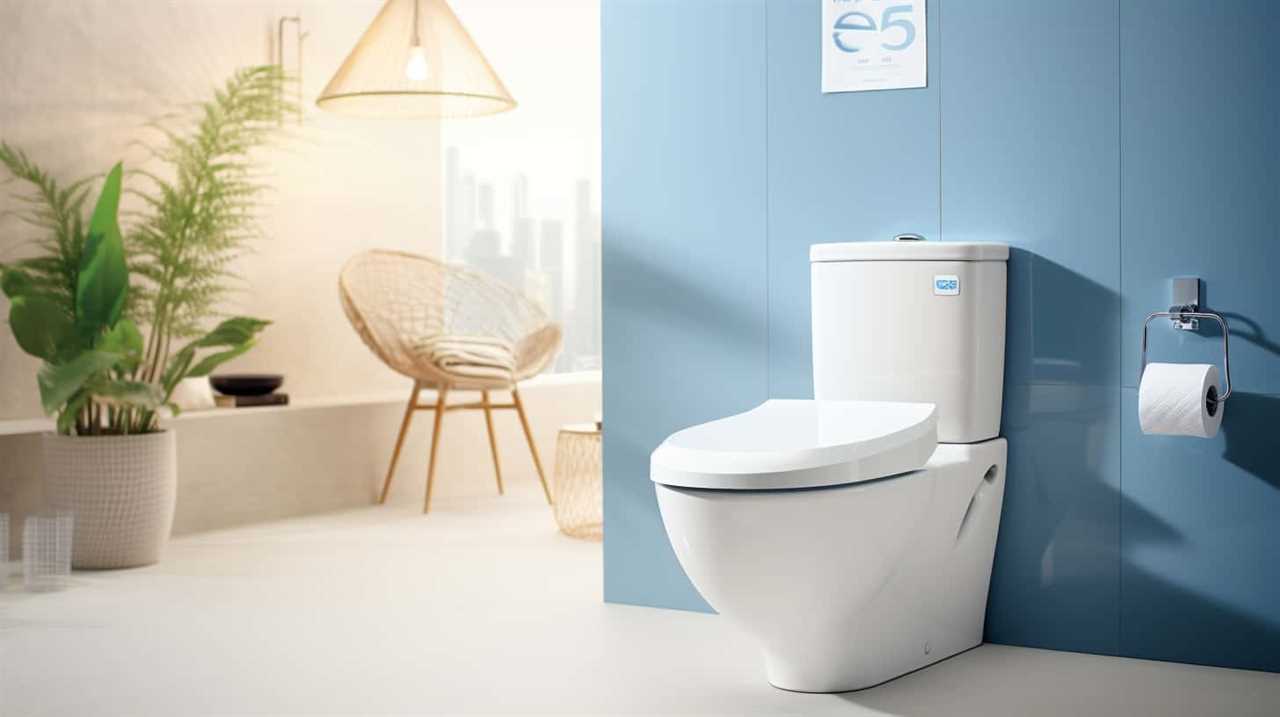
Key Takeaways
- Low water level in a toilet tank can lead to clogs and unpleasant odors.
- Adding water manually to the tank can help maintain the proper water level.
- Regularly checking for leaks, damage, and adjusting the fill valve can prevent low water levels.
- Troubleshooting common issues like tank leaks and faulty parts can help resolve water level problems.
Reasons for Low Water Level
One of the most common reasons for a low water level in our toilet tank is a faulty fill valve. A faulty fill valve prevents the tank from filling up to its proper level, which can lead to various issues such as toilet clogs.
It’s important to maintain the proper water level in the toilet tank as it ensures the effective flushing of waste and prevents clogs from occurring. When the water level is too low, it may not provide enough force to push the waste through the drain, resulting in a clog. Additionally, a low water level can also cause incomplete flushing, leaving behind residue and causing unpleasant odors.
To address this issue, we’ll need certain tools and materials.
Tools and Materials Needed
To manually add water to a toilet tank, we’ll need a few essential tools and materials. Here is a list of what you’ll need:
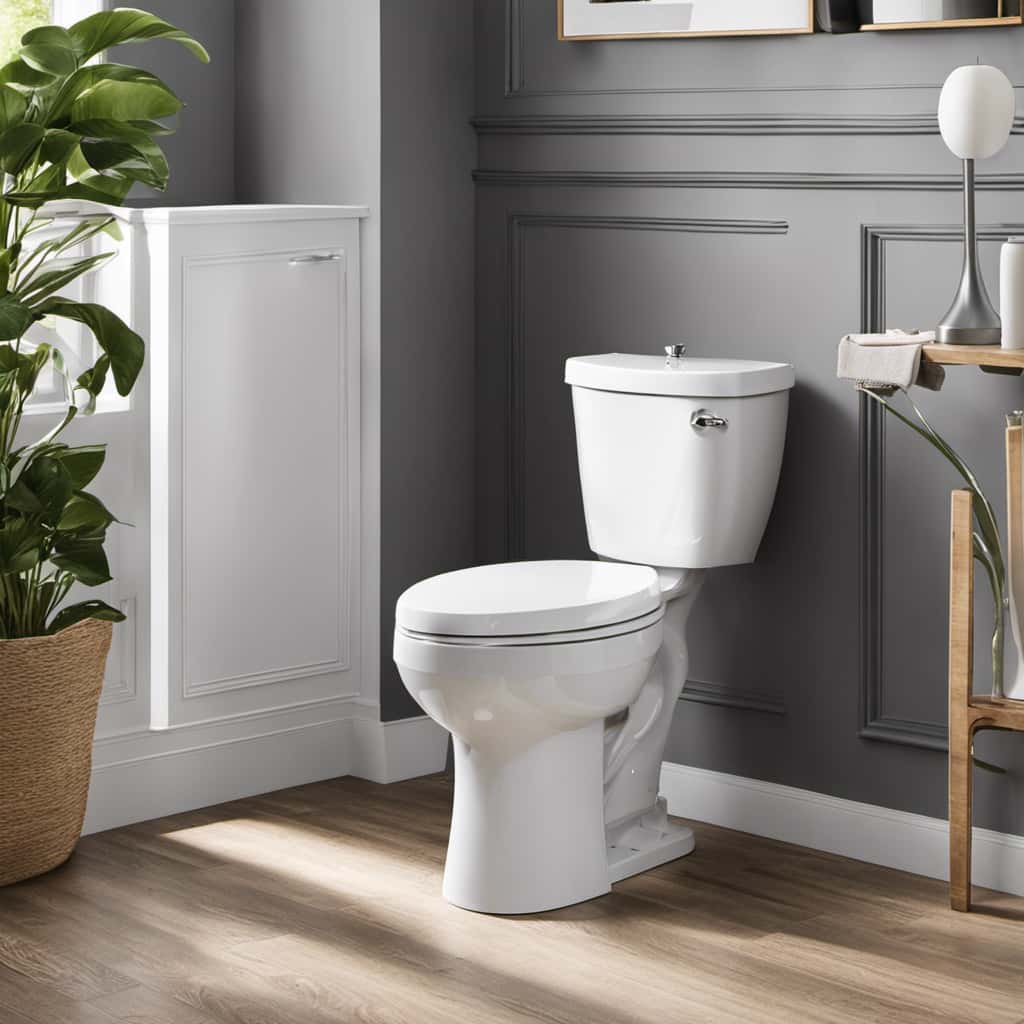
- Adjustable wrench: This tool is necessary for loosening and tightening the water supply line nut that connects the toilet tank to the water source.
- Bucket or container: You’ll need a container to hold the water that you’ll be adding to the toilet tank. A bucket or any other suitable container will work.
- Water: Fill the container with clean water to add to the toilet tank. Ensure that the water is free from contaminants to maintain the cleanliness of the tank.
- Towel or rag: It’s always a good idea to have a towel or rag handy to wipe up any spills or leaks that may occur during the process.
Step-by-Step Instructions
Now, let’s dive into the step-by-step instructions for manually adding water to a toilet tank.
Toilet tank maintenance is essential for the proper functioning of your bathroom fixture, especially if you have water-saving devices installed.
To manually add water to your toilet tank, follow these instructions carefully:
- Locate the water shut-off valve behind the toilet and turn it clockwise to shut off the water supply.
- Lift the toilet tank lid and place it aside in a safe spot.
- Inspect the tank for any visible leaks or damage.
- Locate the fill valve, which is connected to the water supply line, and locate the float. The float is a small plastic or metal device that controls the water level.
- Gently lift the float to the highest position, and hold it there.
- Slowly turn on the water shut-off valve counterclockwise to allow water to enter the tank.
- Keep an eye on the water level and release the float when the tank is filled to the desired level.
- Once the tank is filled, carefully place the tank lid back on and ensure it’s secure.
Following these step-by-step instructions will help you manually add water to your toilet tank effectively. Regular toilet tank maintenance is crucial to ensure the optimal performance of your water-saving devices.
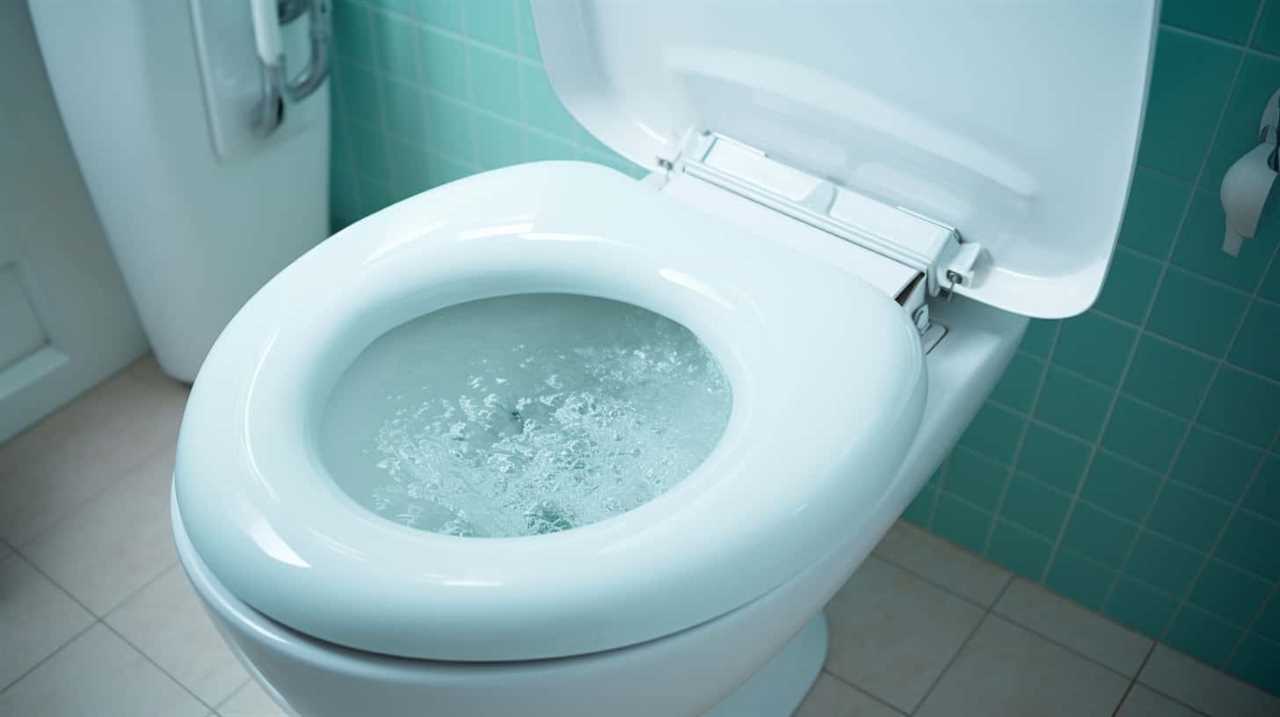
Tips for Maintaining Proper Water Level
To maintain the proper water level in your toilet tank, we recommend regularly checking for any leaks or damage and adjusting the fill valve as needed. Here are some tips for maintaining the proper water level:
- Importance of regular toilet maintenance: Regularly checking for leaks or damage can prevent water wastage and potential water damage to your bathroom.
- Benefits of using a water-saving toilet flush system: Upgrading to a water-saving toilet flush system can help reduce water consumption, saving you money on your water bills and contributing to environmental conservation.
- Adjust the fill valve: If you notice that the water level in your toilet tank is too low or too high, adjust the fill valve accordingly. This will ensure that the toilet flushes properly and efficiently.
- Check for leaks: Periodically check for any leaks in the toilet tank or the water supply line. Leaks can cause the water level to drop, leading to a less effective flush and potential water damage.
Troubleshooting Common Issues
When troubleshooting common issues with a toilet tank, we often encounter problems that can be easily resolved with basic maintenance.
Two common issues that can occur are toilet tank leaks and toilet tank float adjustment. Toilet tank leaks can lead to a constant water flow, resulting in wasted water and higher water bills. To fix this issue, it’s important to check the tank for any cracks or damage and replace any faulty parts, such as the flapper or fill valve.
Another common issue is an incorrect toilet tank float adjustment, which can cause the toilet to constantly run or not flush properly. Adjusting the toilet tank float to the correct water level can resolve this issue. It’s important to ensure that the float is properly positioned and not obstructed by any debris or other objects.
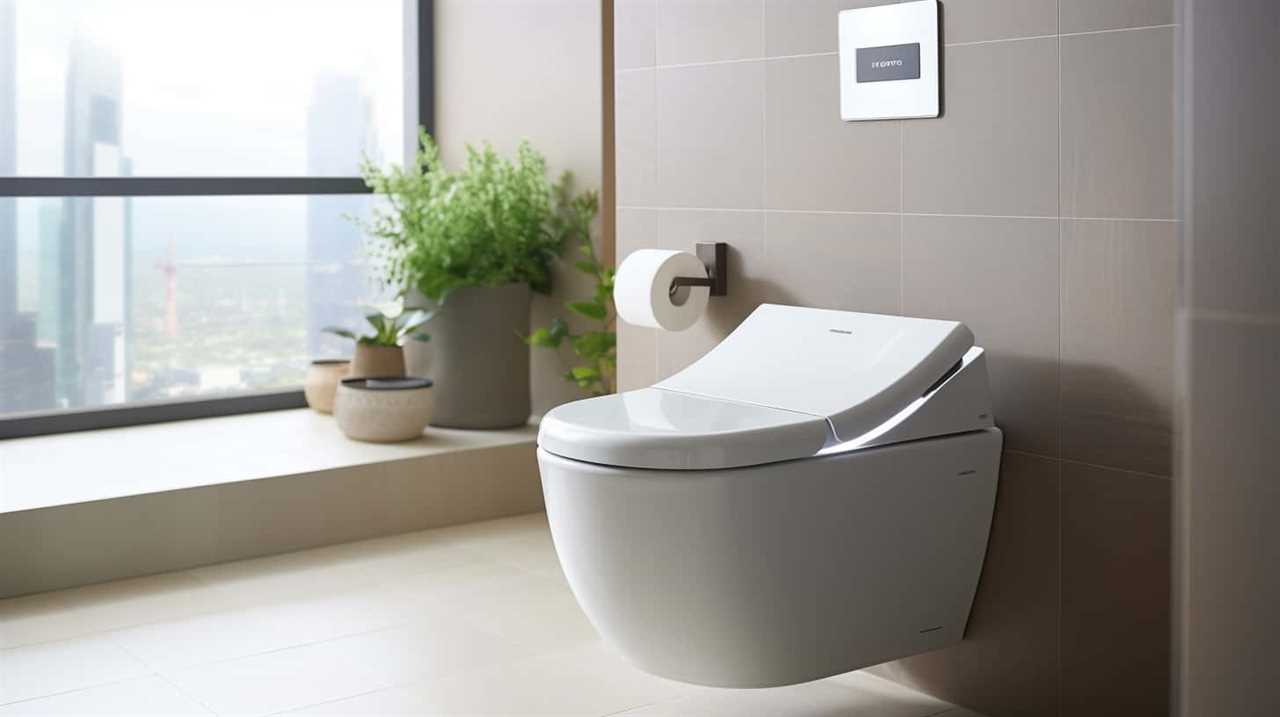
Frequently Asked Questions
Can I Use Any Type of Water to Manually Add to the Toilet Tank?
Yes, we can manually add water to a toilet tank. However, it is important to use clean, potable water to maintain water quality and prevent any potential damage to the tank or plumbing system.
How Often Do I Need to Manually Add Water to the Toilet Tank?
We should regularly check the water level in the toilet tank to ensure proper functioning. Using a measuring cup, we can manually add water as needed, maintaining the optimal level for flushing efficiency.
Is It Safe to Manually Add Water to the Toilet Tank While the Toilet Is in Use?
Yes, we can manually add water to a toilet tank for maintenance and troubleshooting of the water level. However, it is important to ensure the toilet is not in use to prevent any accidents.
Will Manually Adding Water to the Toilet Tank Fix Other Toilet-Related Issues?
Manually adding water to a toilet tank may temporarily fix some toilet-related issues, but it won’t address potential causes that require professional assistance. Troubleshooting and fixing common problems without water addition should be our first approach.
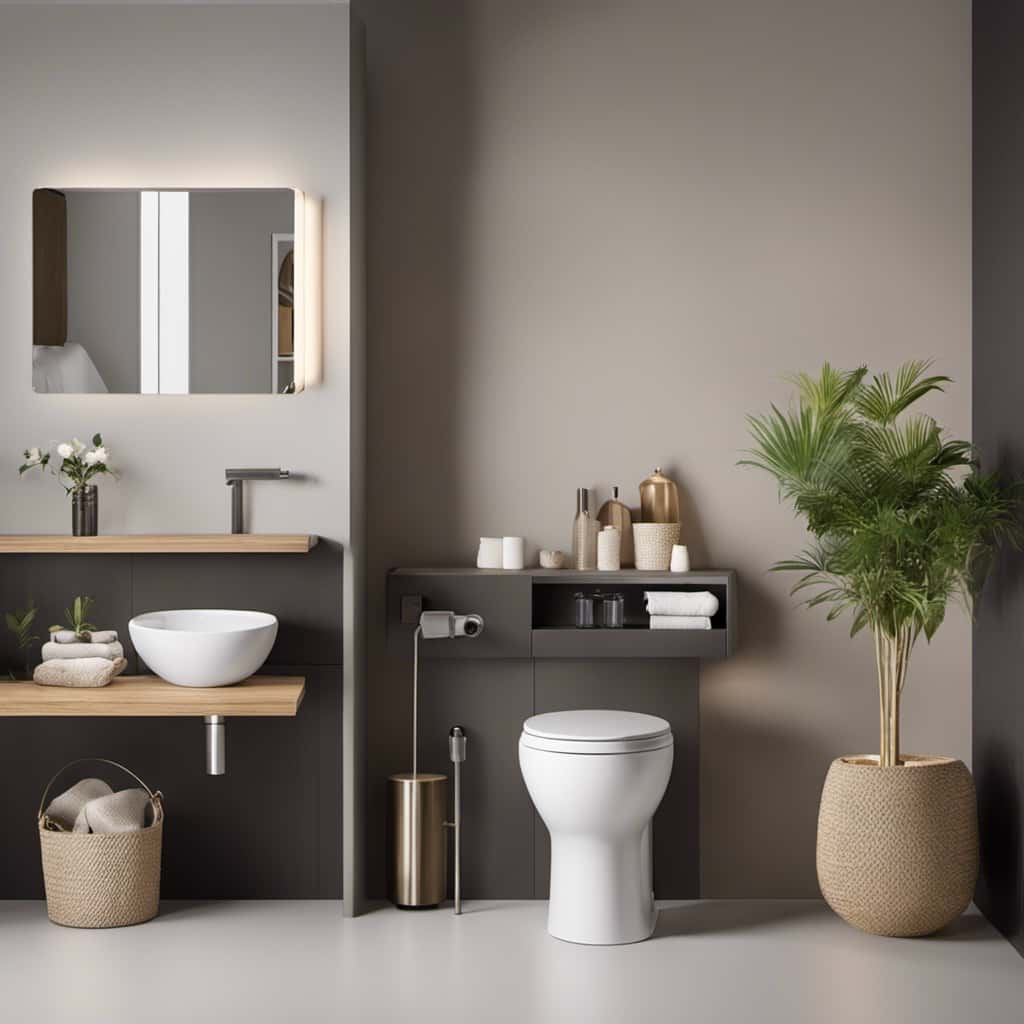
Can I Manually Add Water to the Toilet Tank if My Toilet Is Constantly Running?
Yes, you can manually add water to a toilet tank if it is constantly running. This can help maintain the water level and potentially fix the issue. It is important to identify and address the common causes of a constantly running toilet, as fixing it can save water and prevent damage.
Conclusion
In conclusion, manually adding water to a toilet tank is a simple and straightforward process. By following the step-by-step instructions and using the necessary tools and materials, you can easily maintain a proper water level in your toilet.
Remember to regularly check and adjust the water level to prevent any issues. Just like a well-tuned machine, a well-maintained toilet ensures smooth and efficient operation.
With an impeccable eye for detail and a passion for bathroom-related, Ava leads our editorial team gracefully and precisely.
Under her guidance, Best Modern Toilet has flourished as the go-to resource for modern bathroom enthusiasts. In her free time, you might find Ava exploring antique shops and looking for vintage bathroom fixtures to add to her collection.
Bathtub
Can You Flush Toilet Paper in Puerto Del Carmen

Did you know that more than 80% of tourists in Puerto Del Carmen are curious about whether they can flush toilet paper? Don’t worry, we’re here to reassure you.
In this article, we’ll explore the plumbing infrastructure of Puerto Del Carmen and discuss the benefits of flushing toilet paper.
We’ll also provide tips for proper disposal of other bathroom waste and considerations for travelers with sensitive plumbing systems.
So, let’s dive in and discover everything you need to know about flushing toilet paper in Puerto Del Carmen.
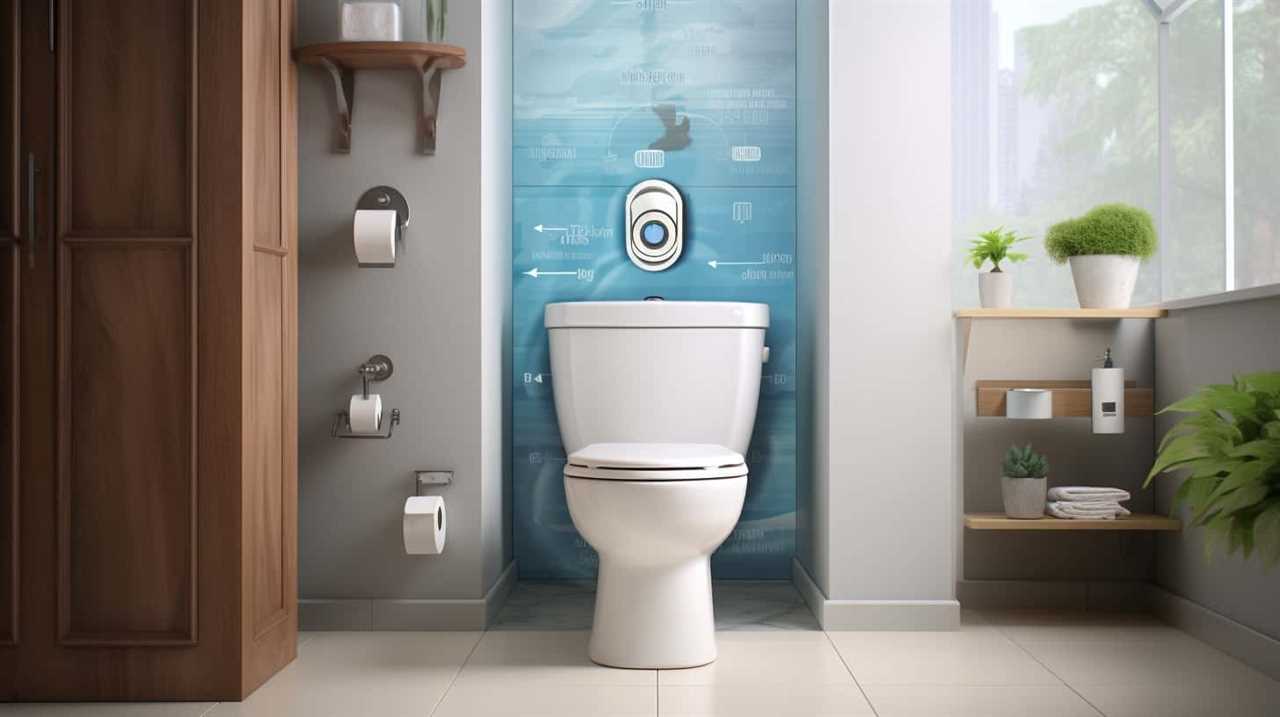
Key Takeaways
- Flushing toilet paper is generally allowed in Puerto Del Carmen.
- The plumbing system is designed to handle toilet paper disposal and is well-maintained.
- Flushing toilet paper saves time and effort compared to separate disposal methods.
- Proper disposal of other bathroom waste such as baby wipes and sanitary napkins is essential to prevent clogs and protect the environment.
Plumbing Infrastructure in Puerto Del Carmen
When it comes to the plumbing infrastructure in Puerto Del Carmen, we’ve found that flushing toilet paper is generally allowed. The water quality in Puerto Del Carmen is exceptional, and the plumbing system is designed to handle the disposal of toilet paper without any issues. The pipes and sewer system are well-maintained, ensuring smooth and efficient waste disposal.
This not only guarantees a hygienic and comfortable experience for residents and visitors but also has a positive environmental impact. By allowing the flushing of toilet paper, Puerto Del Carmen minimizes the need for additional waste management measures and reduces the amount of waste that ends up in landfills.
This responsible approach not only preserves the pristine beauty of the area but also helps to maintain the delicate balance of the ecosystem.
Benefits of Flushing Toilet Paper
Flushing toilet paper in Puerto Del Carmen offers numerous benefits for both residents and the environment. Not only does it contribute to the convenience and hygiene of daily life, but it also has a positive environmental impact. By flushing toilet paper, residents can avoid the hassle of disposing of it in a separate trash bin, saving time and effort. Additionally, it helps maintain a cleaner and more pleasant bathroom environment, reducing the risk of odors and bacteria. From an environmental standpoint, flushing toilet paper eliminates the need for additional waste management processes, reducing the overall carbon footprint. Here is a table summarizing the benefits of flushing toilet paper in Puerto Del Carmen:
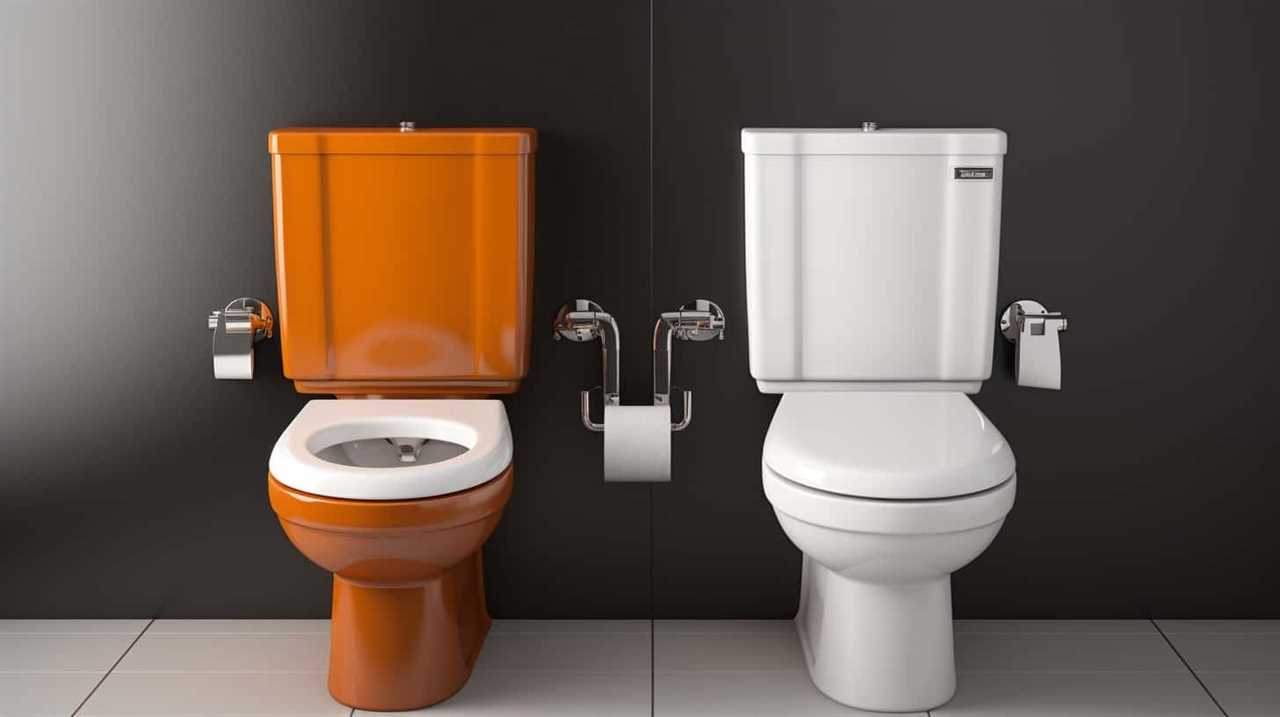
| Benefits |
|---|
| Convenience |
| Hygiene |
| Environmental Impact |
Proper Disposal of Other Bathroom Waste
To ensure proper sanitation and waste management, we must address the appropriate disposal of other bathroom waste in Puerto Del Carmen.
While we’ve discussed the flushing of toilet paper, there are other items that shouldn’t be flushed down the toilet. Proper disposal methods are crucial to prevent clogs and protect the environment.
Items such as baby wipes, sanitary napkins, and cotton swabs should be placed in a waste bin instead of being flushed. These items don’t break down easily and can cause blockages in the sewage system. When flushed, they can also end up in rivers and oceans, contributing to pollution and harming marine life.
Tips for a Smooth Flushing Experience
To ensure a smooth flushing experience and prevent any potential clogs, we can follow a few simple tips:
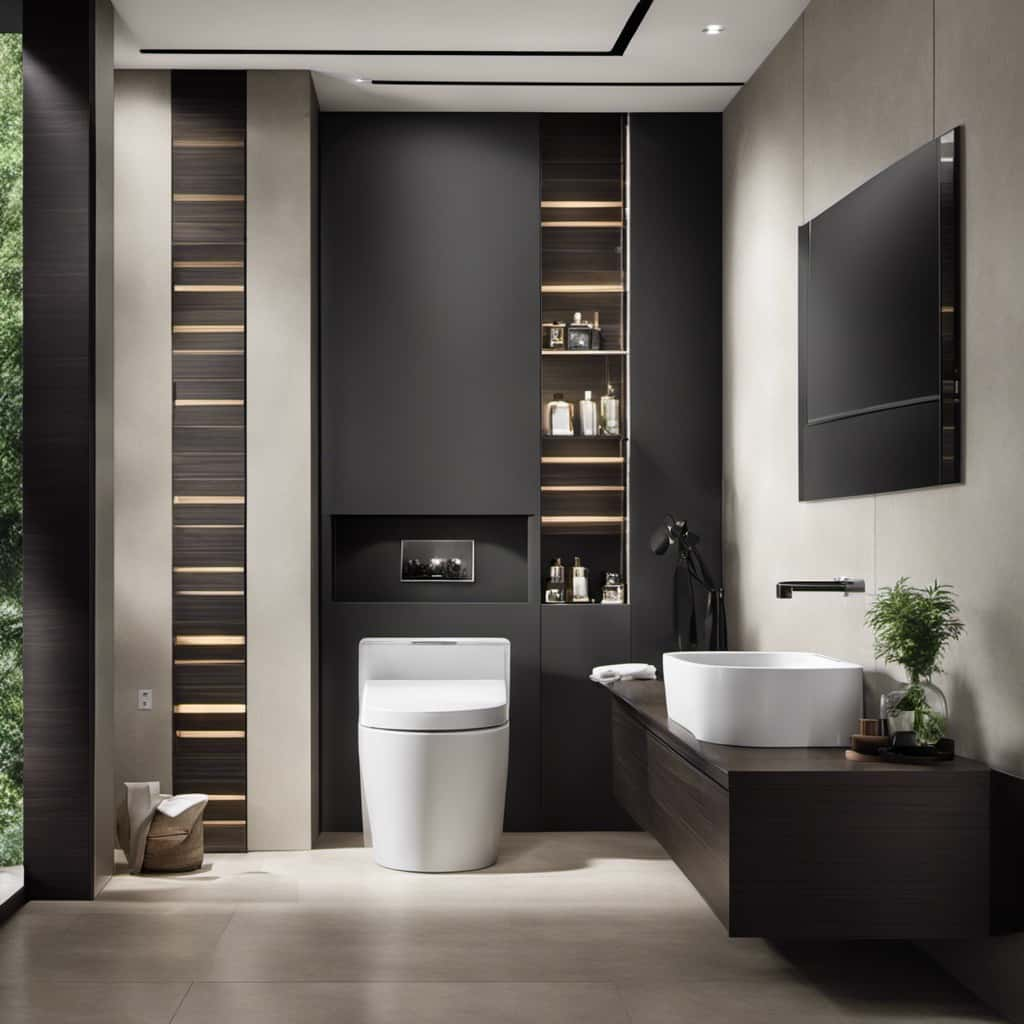
- Use the right amount of toilet paper: One or two squares should be enough for most tasks. Avoid excessive use to prevent clogging.
- Consider toilet paper alternatives: If you’re looking for eco-friendly bathroom options, consider using bidets or wet wipes specifically designed to be flushed.
- Flush properly: After using the toilet, make sure to hold down the flush lever until all the waste and toilet paper have been completely flushed away. This will help prevent any lingering debris from causing a clog.
- Regular maintenance: Keep your toilet in good condition by performing regular maintenance, such as checking for leaks, cleaning the flush holes, and using a plunger if necessary.
Considerations for Travelers With Sensitive Plumbing Systems
When traveling to Puerto Del Carmen, it’s important for us to consider the sensitivity of our plumbing systems. This is especially true for those of us who are traveling with septic systems or have eco-friendly alternatives in mind.
Septic systems are designed to treat and dispose of wastewater, but they can be easily overwhelmed by excessive toilet paper usage or other non-biodegradable materials.
To prevent any plumbing issues during our trip, it’s advisable to use eco-friendly alternatives such as bidets or wet wipes that are specifically designed to be flushed down the toilet. These alternatives aren’t only gentle on our plumbing systems but also help us reduce our environmental impact.
Frequently Asked Questions
Can I Flush Baby Wipes or Other Non-Flushable Products Down the Toilet in Puerto Del Carmen?
Yes, we can flush toilet paper in Puerto Del Carmen. However, it is important to note that non-flushable products, such as baby wipes, should not be flushed. There are alternative toilet paper options available.

Are Bidets Commonly Found in Bathrooms in Puerto Del Carmen?
Bidets aren’t commonly found in bathrooms in Puerto Del Carmen. Instead, many people use alternative methods for disposing of toilet paper, such as placing it in a bin. This practice helps prevent plumbing issues.
Is It Safe to Drink Tap Water in Puerto Del Carmen?
Yes, it is safe to drink tap water in Puerto Del Carmen. The tap water quality is excellent. However, if you prefer alternatives, bottled water is widely available and many restaurants offer filtered water.
How Often Are the Sewage Systems in Puerto Del Carmen Maintained and Cleaned?
Yes, we maintain and clean the sewage systems in Puerto Del Carmen regularly. Our team ensures the frequency of sewage system maintenance is sufficient to keep them functioning properly. Our cleaning procedures are thorough and effective.
Are There Any Specific Rules or Regulations Regarding Toilet Paper Disposal in Puerto Del Carmen?
Yes, there are specific regulations in Puerto Del Carmen regarding toilet paper disposal. It is important to follow these rules to avoid clogging the sewage system and causing environmental damage by flushing non-flushable products.

Conclusion
So, can you flush toilet paper in Puerto Del Carmen?
The answer is yes! With its modern plumbing infrastructure, you can enjoy the convenience of flushing toilet paper without any worries.
Just remember to dispose of other bathroom waste properly to keep the system running smoothly.
Whether you’re a traveler or a local, these tips will ensure a hassle-free flushing experience.
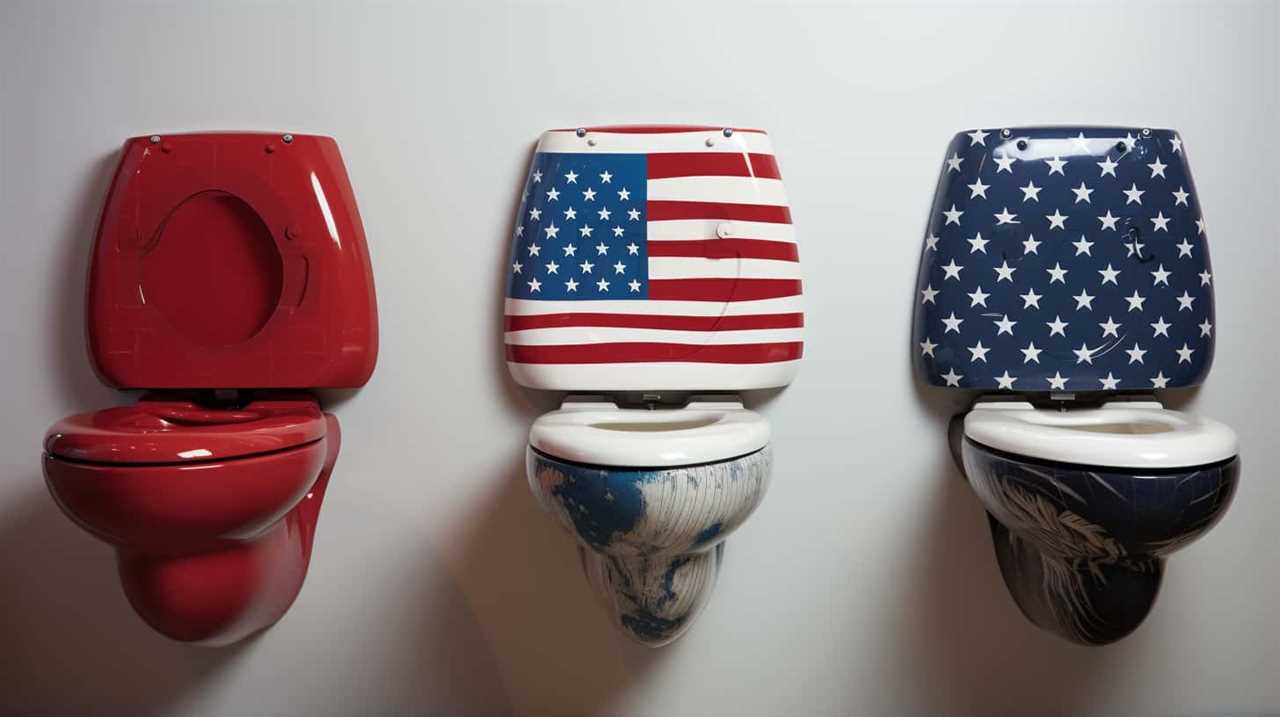
So go ahead, relax, and let the toilet paper disappear with a satisfying whoosh, leaving you with a clean and refreshed feeling.
With an impeccable eye for detail and a passion for bathroom-related, Ava leads our editorial team gracefully and precisely.
Under her guidance, Best Modern Toilet has flourished as the go-to resource for modern bathroom enthusiasts. In her free time, you might find Ava exploring antique shops and looking for vintage bathroom fixtures to add to her collection.
Bathtub
What to Do if You Flush a Large Object Down the Toilet

Have you ever been in a situation where a large object gets flushed down the toilet? It can be a troublesome predicament that needs immediate attention.
Well, fear not! In this article, we will guide you through the steps you need to take to handle this plumbing crisis with ease. From assessing the situation to seeking professional help if needed, we’ve got you covered.
So, let’s dive in and master the art of toilet rescue!
Key Takeaways
- Assess the situation by examining the toilet bowl, checking for signs of leakage, and inspecting the surrounding area for water damage.
- Stop the water flow by locating and turning off the shut-off valve near the base of the toilet to prevent further water from entering the bowl.
- If possible, retrieve the object using a toilet auger or a long-handled tool with a hook, being careful not to push it further into the drain.
- If unable to retrieve the object, consider using a plumbing snake to break up the clog or hook onto the object. If the situation becomes complex, seek professional help from a plumber specializing in toilet repairs and blockage removal.
Assess the Situation
First, we need to assess the situation and determine the severity of the problem after flushing a large object down the toilet. Assessing the damage is crucial in order to take immediate action.

Start by examining the toilet bowl to see if it’s filled with water or overflowing. Take note of any signs of leakage or unusual sounds coming from the pipes. Carefully inspect the surrounding area for any water damage or wet spots on the floor. This will help you understand the extent of the problem and guide your next steps.
Once you have assessed the situation, you can move on to stop the water flow and prevent further damage.
Stop the Water Flow
To stop the water flow after flushing a large object down the toilet, we can use a shut-off valve located near the base of the toilet. This valve is typically a small, round knob that can be turned clockwise to shut off the water supply to the toilet.
By doing this, you can prevent any further water from entering the toilet bowl and potentially causing more damage or flooding. It’s important to act quickly in order to minimize the risk of overflowing and water damage to your bathroom.

Once the water flow has been stopped, you can then proceed to assess the situation and determine the best course of action to remove the object and prevent future plumbing mishaps.
Remember to always exercise caution when dealing with plumbing issues and consider seeking professional help if needed.
Retrieve the Object (If Possible)
After stopping the water flow, we can now focus on retrieving the object from the toilet. It’s important to approach this task with caution to avoid causing further damage to the toilet.
First, put on a pair of rubber gloves to protect your hands.

Use a toilet auger or a long-handled tool with a hook at the end to carefully reach into the toilet bowl and try to grasp the object. Gently maneuver the tool around the object, being mindful not to push it further into the plumbing system.
If the object is within reach, carefully lift it out of the toilet. If you encounter any resistance or are unable to retrieve the object, it’s best to stop and call a professional plumber to avoid causing further toilet damage.
Transitioning to the next section, if retrieving the object manually isn’t possible, you can try using a plumbing snake.
Use a Plumbing Snake
Now, let’s move on to using a plumbing snake to retrieve the object from the toilet. A plumbing snake is a handy tool that can be used to unclog toilets and pipes. It consists of a long, flexible metal cable with a coiled end. Here’s how you can use a plumbing snake to tackle the clog and retrieve the flushed object:
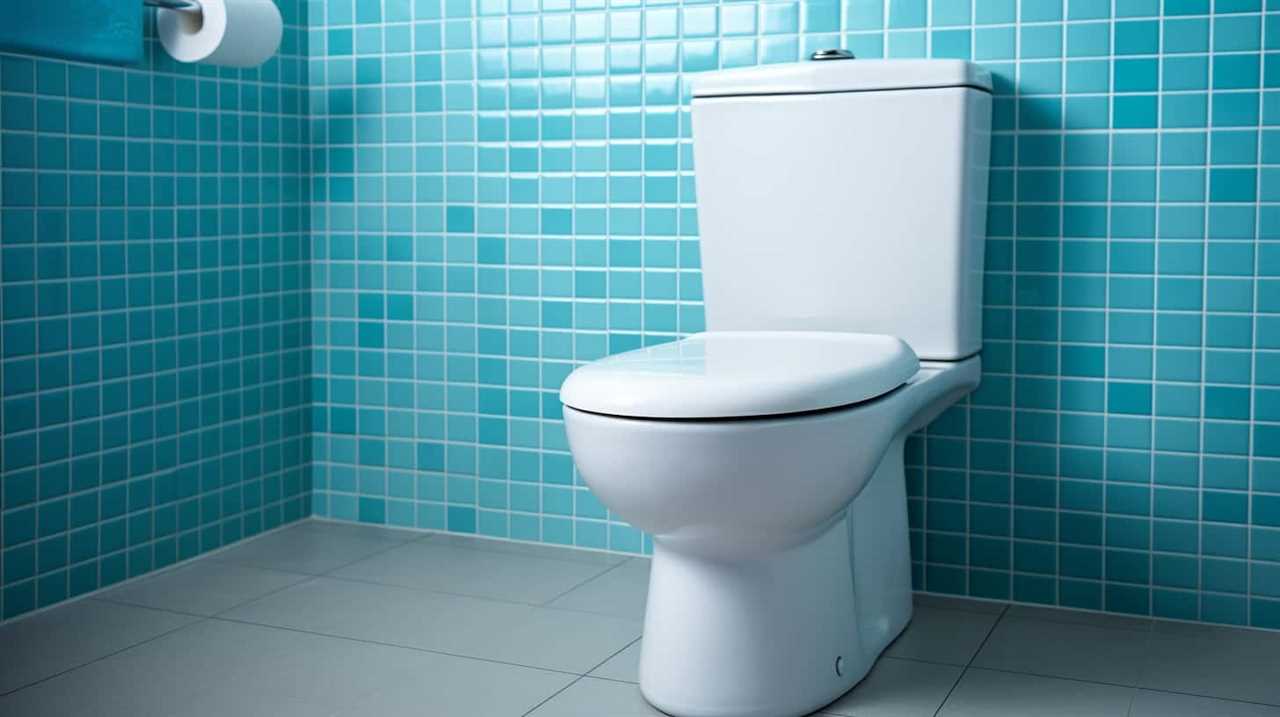
| Step | Instructions |
|---|---|
| 1 | Put on gloves and protective eyewear. |
| 2 | Insert the coiled end of the plumbing snake into the toilet bowl. |
| 3 | Slowly rotate the handle of the snake clockwise to feed it into the drain. |
| 4 | Continue pushing the snake further into the drain until you feel resistance. |
| 5 | Rotate the handle counterclockwise to break up the clog or hook onto the object. |
| 6 | Gently pull the snake back out, taking care not to damage the toilet bowl. |
| 7 | Dispose of the flushed object properly and flush the toilet to ensure it is unclogged. |
Using a plumbing snake is an effective DIY plumbing method to retrieve objects and unclog toilets. Remember to follow these steps carefully to avoid causing further damage.
Seek Professional Help if Necessary
If the object can’t be retrieved using a plumbing snake, we may need to seek professional help. In such cases, it’s advisable to contact a plumber who specializes in toilet repairs and blockage removal. Professional plumbers have the necessary tools, expertise, and experience to handle more complex situations. They can utilize advanced techniques like hydro jetting or drain cameras to locate and remove the object safely.
Seeking professional help ensures that the issue is resolved efficiently and effectively, minimizing any further damage to the plumbing system. Additionally, it’s important to learn from the experience and take steps to prevent future accidents. This includes being mindful of what gets flushed down the toilet and considering the use of drain screens or toilet locks to avoid similar situations in the future.
Frequently Asked Questions
Can I Use a Plunger to Try and Retrieve the Object?
Yes, we can try using a plunger to retrieve the object, but if it doesn’t work, we should consider calling a professional plumber or exploring alternative methods to safely remove the object.
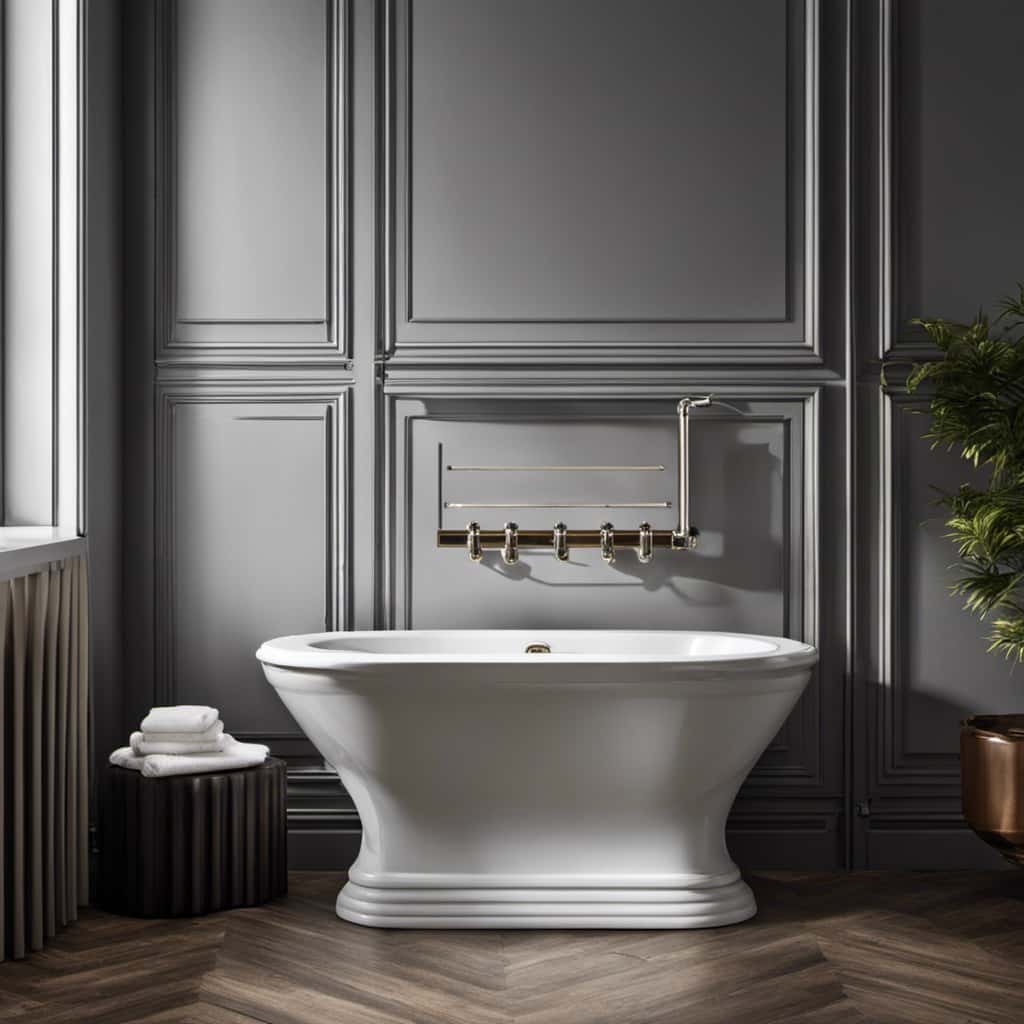
What Are Some Signs That the Object May Have Caused a Blockage in the Plumbing System?
If you notice slow draining, gurgling sounds, or water backing up in other fixtures, these are signs that a large object may have caused a blockage in the plumbing system. To prevent this, be mindful of what you flush and consider using a toilet lock.
Can I Use Chemical Drain Cleaners to Dissolve the Object?
We don’t recommend using chemical drain cleaners to dissolve the object. There are alternative methods, such as using a plunger or a plumbing snake, that are more effective and won’t cause further damage. If these methods don’t work, it’s best to seek professional assistance.
Are There Any Potential Dangers or Risks Associated With Using a Plumbing Snake?
When using a plumbing snake, there are potential risks if not used properly. It is important to follow the proper usage instructions to avoid damaging the pipes or causing further clogs.
Will My Homeowner’s Insurance Cover the Cost of a Professional Plumber if Needed?
Yes, homeowner’s insurance may cover the cost of a professional plumber if needed. However, it’s important to consider DIY methods first to avoid potential risks and dangers.
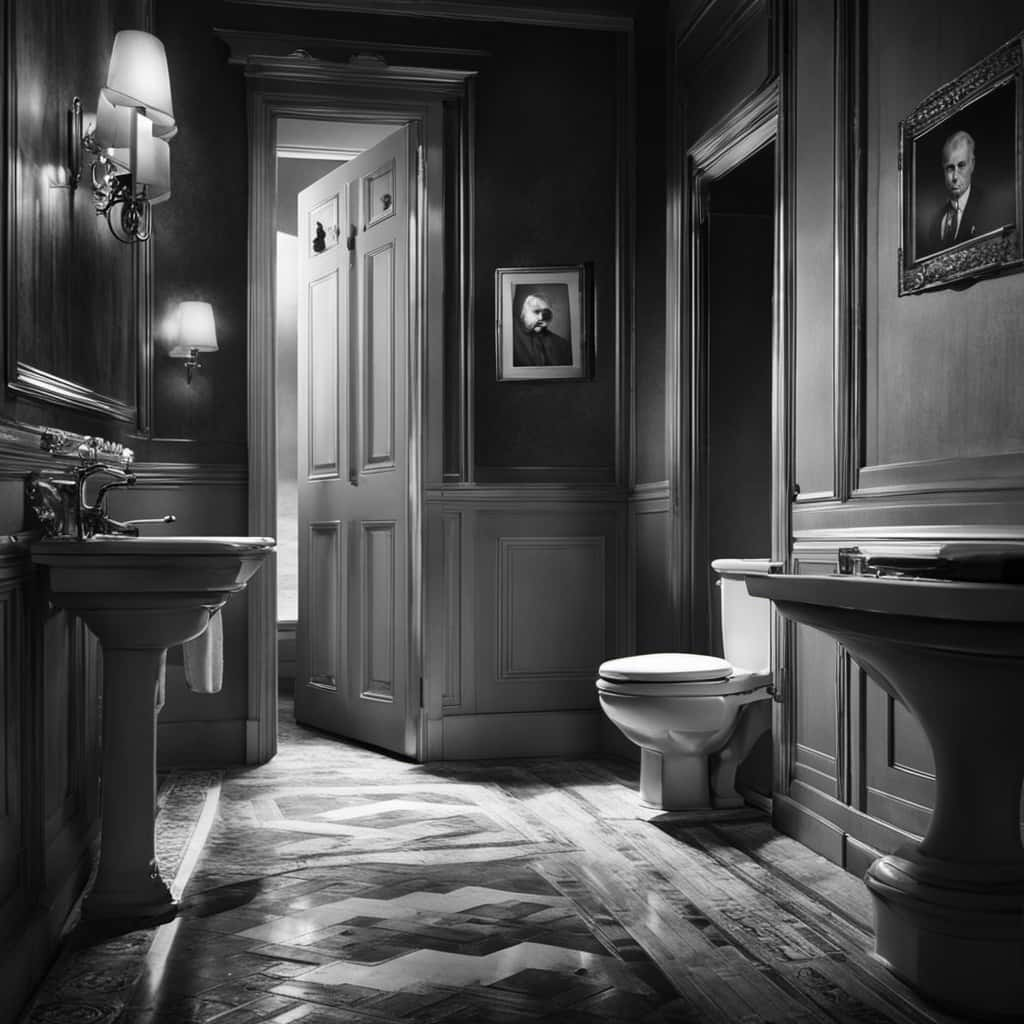
Conclusion
In conclusion, if you find yourself in the unfortunate situation of flushing a large object down the toilet, it’s important to assess the situation calmly and act quickly.
Stop the water flow, try to retrieve the object if possible, and use a plumbing snake if needed. Remember, seeking professional help may be necessary to resolve the issue completely.
Don’t let this mishap send you down the drain like a ship without a captain – take control and tackle the problem head-on.
With an impeccable eye for detail and a passion for bathroom-related, Ava leads our editorial team gracefully and precisely.
Under her guidance, Best Modern Toilet has flourished as the go-to resource for modern bathroom enthusiasts. In her free time, you might find Ava exploring antique shops and looking for vintage bathroom fixtures to add to her collection.
-

 Reviews2 months ago
Reviews2 months agoBest Toilet Air Freshener: Top 10 Picks for a Fresh-Smelling Bathroom [2024]
-

 FAQ - Advanced Bathroom Queries3 months ago
FAQ - Advanced Bathroom Queries3 months agoWhat Size Pipe for Toilet Drain
-

 FAQ - Advanced Bathroom Queries3 months ago
FAQ - Advanced Bathroom Queries3 months agoGuide: How to Use Drano Max Gel in Your Toilet
-

 FAQ - Advanced Bathroom Queries1 month ago
FAQ - Advanced Bathroom Queries1 month agoWhich Countries Use Bidets the Most
-

 FAQ - Advanced Bathroom Queries3 months ago
FAQ - Advanced Bathroom Queries3 months agoWhy Does My Poop Leave Streaks in the Toilet
-

 Reviews2 months ago
Reviews2 months agoBest Waterless Toilets: Top Options for Eco-Friendly Bathrooms [2024]
-

 Buying Guides2 months ago
Buying Guides2 months agoWhat to Do When You Accidentally Flushed Something Down the Toilet
-

 FAQ - Advanced Bathroom Queries3 months ago
FAQ - Advanced Bathroom Queries3 months agoHow Do Toilets Work in Bali





















